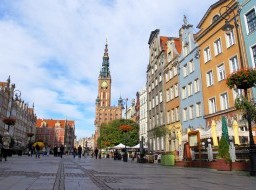St. Mary's Church
For several long centuries the largest Lutheran church in the world was St. Mary’s Church in Gdansk – an enormous structure built from brick in Gothic style. This is the third largest brick church in the world after San Petronio Basilica in Bologna, Italy and Munich Frauenkirche in Germany. The church is located in the historical centre of Gdańsk – an old port city which started to develop around the late 10th century. Christianity was introduced here around the same time. It is not known when the first church was built in the site of present day St. Mary’s Church, but around 1243 here most likely was a wooden church. The first brick church was built here in 1343 – 1360: fairly large for its time but considerably smaller than the present one. In 1379 there was started the construction of the present church. Design and works were led by local craftsman Heinrich Ungeradin. Architecture of the church most likely was inspired by the St. Mary’s Church in Lübeck – the first great example of the Brick Gothic style. Such great churches devoted to St.Mary were built in numerous cities – members of the Hanseatic league. Construction works of the enormous church continued for a long time, until the 1502. After several upheavals in the city in 1525 – 1526 the Lutheran Christianity became the leading branch in religion in the city. Initially, in 1536 – 1572 St. Mary’s Church was used both for Roman Catholic and Lutheran services. Since 1572 for four centuries it was a Lutheran church – the largest Lutheran church in the world. Interesting finds were made here in the 19th and 20th when in the church were found rich collections of medieval art: ornamented garments, altar cloths, paintings and other items. The church was heavily damaged in the end of the World War II, in March 1945 as the city was stormed by the Red Army. The church was burned down and many vaults collapsed, floor of the church was demolished by Soviet soldiers pillaging the corpses in the basement. Happily many, some 60% of the artworks were preserved because many items were evacuated and hidden in the nearby villages around the city. The church was transferred to a Catholic diocese and in 1946 the reconstruction of the church was started. In 1955 the main works were completed but further renovations of interior are ongoing up to this day. The church is 105.5 m long and its nave is 66 m wide and up to 29 m high. There is enough room for 25,000 people inside. The tower of the church is 82 m tall and dominates the skyline of the old city. |




